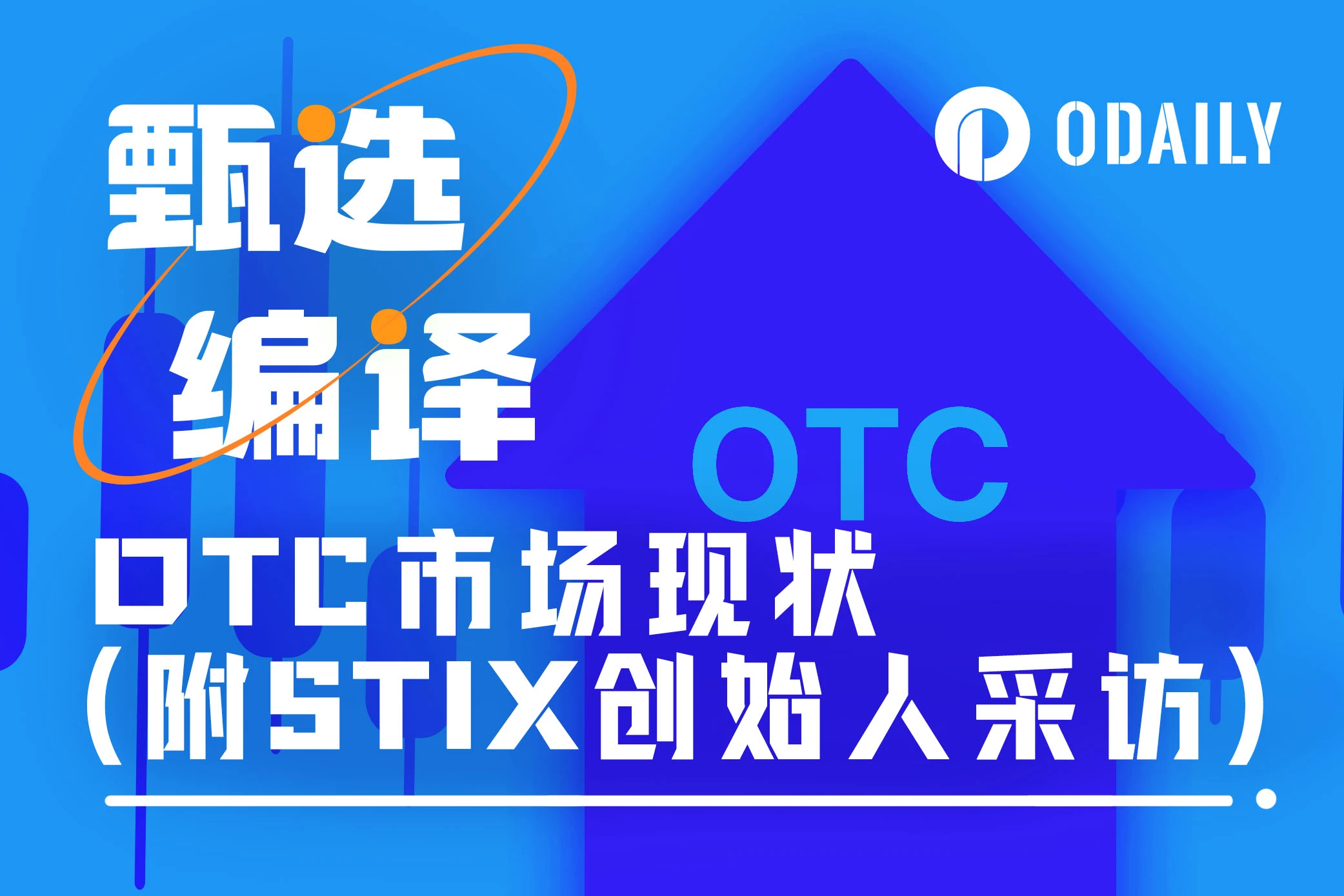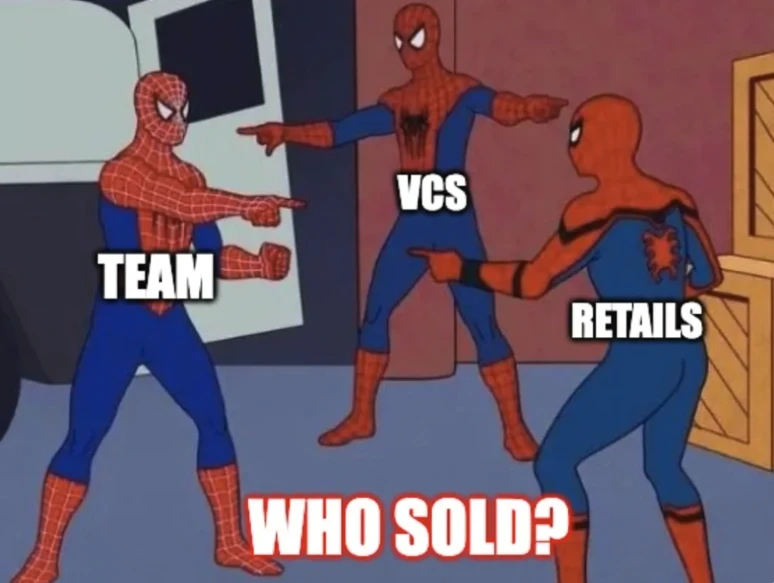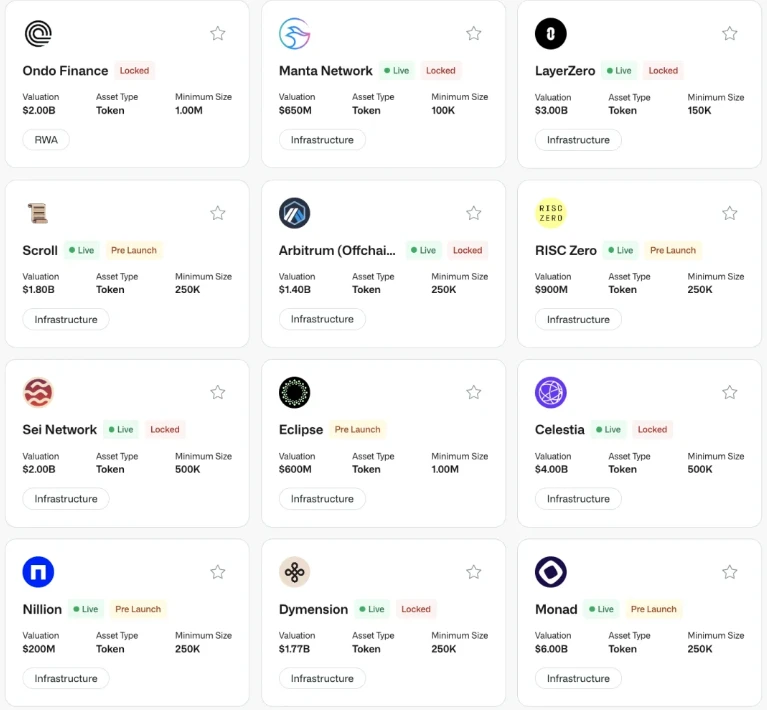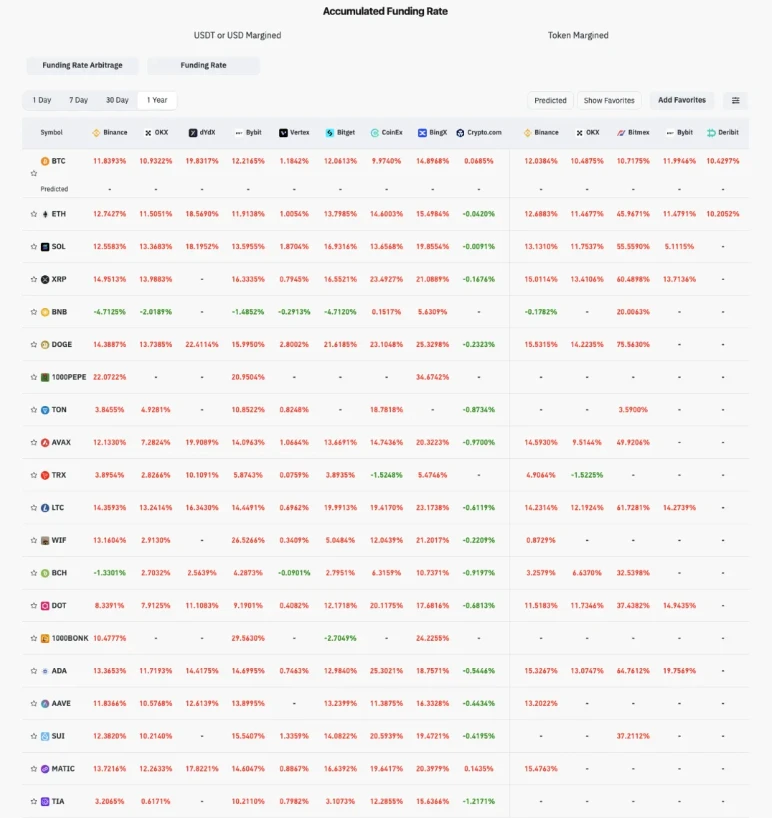Original article by Min Jung
Compiled by Odaily Planet Daily Golem ( @web3_golem )

summary
The secondary OTC market is a place where people can buy and sell various assets, including locked tokens, equity or SAFTs (Simple Agreement for Future Tokens), which are difficult to trade on public exchanges. Today, the term secondary OTC market mainly refers to the buying and selling of locked tokens.
The main sellers in the secondary OTC market include VCs, project teams, and foundations, who are often motivated by early profits or managing selling pressure. Buyers are generally divided into two categories: hodlers who believe in the long-term potential of tokens and are attracted by token discounts, and hedgers who profit from price differences through financial means.
The secondary OTC market is gaining increasing attention as it reflects the pessimism of the market, with tokens often being sold at a significant discount due to limited buyer willingness. Nevertheless, the secondary OTC market still plays a key role in managing liquidity and reducing direct selling pressure on public exchanges, helping to build a more stable and resilient crypto ecosystem.

Figure 1: Market status, source: imgflip
While the secondary OTC market is largely invisible to most retail investors, its importance is rapidly increasing among industry insiders such as VCs, project teams, and foundations. As the cryptocurrency market develops dynamically, the secondary OTC market is becoming an important way to manage liquidity and lock in profits, especially in situations where valuations are high but liquidity is limited. Therefore, this article will cover: 1) What is the secondary OTC market, 2) Who are the participants and their motivations, 3) Some thoughts on the current market situation, and 4) A text interview with Taran, founder of the OTC trading platform STIX.
What is the secondary OTC market?
The secondary OTC (over-the-counter) market is a private trading space that allows buyers and sellers to directly negotiate and execute trades of assets such as tokens, equity or investment contracts (such as SAFT, Simple Agreement for Future Tokens) outside of public exchanges. Most assets listed on the secondary OTC market cannot be traded on regular exchanges such as Binance or OKX for various reasons.
Many crypto projects have tokens that are locked for a certain period of time, and the secondary OTC market provides a way for investors and teams to sell these assets before they are tradable (unlocked). Today, the term secondary OTC market mainly refers to the buying and selling of locked tokens of TGE or even pre-TGE projects. This article will focus on the buying and selling of locked tokens of TGE projects.

Figure 2: What the secondary OTC market looks like, source: STIX
Why the secondary OTC market is booming
The main driving force behind the boom in the secondary OTC market is the strong incentive for stakeholders to sell their holdings. Currently, many of the top 20 tokens are trading at nearly 50% discounts with a one-year lockup period, while tokens of projects outside the top 100 are even trading at discounts of up to 70%. For example, a token priced at $1 on an exchange like Binance may only be sold for $0.3 on a platform like STIX, with a one-year lockup period and an additional two-year monthly unlock period.
This trend has a lot to do with the recent market environment of high FDV, low circulation, and growing aversion to VC coins. As explained in the article Is FDV a Meme? , while there are a large number of new projects entering the market, there are no corresponding new users or liquidity to support this huge supply. Therefore, as more tokens are unlocked, token prices will naturally fall.
Furthermore, many of these tokens provide little value to the market and are often overvalued relative to their actual user base and utility. The project teams and VCs that initially invested in these projects have recognized this and are choosing to sell them now at a discount that would otherwise be even lower in the future.

Figure 3: Existing transactions in the market, source: Presto Research
Buyers and sellers and their motivations
Seller and reason
Project Team
Even with a token sale discount of 50-70%, the project teams are usually profitable. These project teams are small, usually 20-30 people, and they may only take 2-3 years to build the project. Despite the relatively short development cycle and limited initial investment, the FDV valuation of these projects can be as high as $3 billion or more.
In Web2, it is almost impossible for such a small team to create a $1.5 billion company in such a short time. Given this situation, many projects prefer to sell their tokens at a discount, knowing that they have the best chance to get a profit now rather than holding on to it and risking a possible drop in value later.
VC
VCs are also facing a similar situation as project teams. Recent market conditions have led to rapid valuation increases, with seed rounds typically occurring six months after pre-seed rounds and at triple valuations. In some cases, VCs are even conducting multiple rounds at the same time, offering different valuations for simultaneous investments. Therefore, unless they invest in the final stages before TGE, many VCs can still make a significant profit even if they sell at a 50% discount in the secondary market.
The current market environment drives VCs to sell tokens and seize the opportunity to lock in profits. In addition, in the current market environment, limited partners (LPs) in venture capital funds have begun to pay more attention to the DPI (distribution of paid-in capital) indicator, which further motivates VCs to achieve returns, thereby strengthening the trend of selling in the secondary OTC market.
foundation
Foundations may have slightly different motivations for participating in the secondary OTC market. While some foundations may recognize that their tokens are overvalued and want to sell quickly, others may strategically buy. A common strategy is to sell the unlocked tokens to investors at a discount with a one-year lockup.
This approach reduces direct selling pressure on the open market while still allowing the foundation to raise necessary operating funds. In many cases, this type of transaction can be seen as one of the positive uses of the secondary OTC market because it meets the foundations operating funding needs while maintaining market stability.
Buyers and reasons
Hodlers
The first category of buyers in the secondary OTC market are those who believe in the long-term value of the token. These people are often called “hodlers” who believe that the project will succeed, are willing to buy tokens at a 50% discount, and intend to hold them for several years.
For these buyers, the opportunity to purchase tokens at a discount is attractive because they plan to remain invested in the project for a long time and expect the value of the tokens to increase as the project develops. The high discount rate provides them with a favorable entry point, allowing them to accumulate more tokens at a lower cost.
Hedger
The second category of buyers is driven by looking for opportunities to profit from token discounts through strategic financial strategies. These buyers are called hedgers and they use perpetual contracts and other financial instruments to lock in profits from discounted tokens. By buying tokens at a 50% discount and shorting them at the same time, they can earn a return equivalent to the discount.
In addition, they can earn funding rates, which can further increase returns if the rates are positive. This approach allows hedgers to take advantage of price differences between the secondary OTC market and the open market, which can be a profitable strategy for those who are good at managing financial risk.
Why cant sellers be hedgers themselves?
While it may seem logical for sellers (e.g. VCs and project teams) to hedge their positions like buyers rather than sell at a huge discount, several factors make this approach impractical, such as regulatory hurdles and liquidity constraints.
On the regulatory side, VCs often face strict rules that restrict their ability to engage in certain financial activities, such as shorting tokens — an essential component of an effective hedging strategy. In addition to these regulatory restrictions, hedging itself requires significant capital to avoid liquidation risk. Sellers need to post significant collateral, often in excess of the value of the tokens they are trying to hedge, because while the downside to a token’s price is limited, the upside is potentially unlimited. This creates a situation where the financial requirements for hedging are prohibitive, especially given that much of the wealth of VCs and project teams is tied up in the tokens themselves, not in liquid cash.
Furthermore, hedging is not as simple as it seems. There are many complex factors to consider, such as counterparty risk (the possibility of a platform failure or bankruptcy) and the risk associated with funding rates, which can go negative, further complicating the strategy and potentially leading to unexpected losses.
What does the current secondary OTC market situation mean?
Compared to public exchanges, secondary OTC markets are currently showing more pessimism, with tokens struggling to find buyers even when they are sold at deep discounts (sometimes as much as 70%). This is in stark contrast to public exchanges, where investors are often rewarded for shorting tokens through positive funding fees. While it is critical to understand the intentions of secondary market participants, this trend may reflect the cautious approach taken by market insiders in responding to the current situation.

Figure 4: 1-year funding rates are positive for most tokens. Source: Coinglass
The role of the secondary OTC market
Despite the bearish sentiment, activity in the secondary OTC market is not entirely negative. In fact, the existence of an active secondary market plays a vital role in the overall health of the broader crypto ecosystem. By facilitating the transfer of tokens between sellers and buyers, secondary markets allow traders to profit outside of traditional exchanges. This process can help mitigate the impact of large-scale token unlocks, which are often viewed as bearish factors because they put more selling pressure on the market.
By enabling these transactions to take place over the counter, the secondary market reduces the direct selling pressure faced by retail investors when tokens are unlocked. This shift helps to build a more stable and resilient market, where token unlocks no longer necessarily lead to significant price drops, but instead support a healthier and more balanced market environment.
A conversation with Taran, founder of STIX
Taran is the founder of STIX, an over-the-counter trading platform for private cryptocurrency transactions. STIX was founded in early 2023. The main sellers on the platform are team members, early investors, and treasuries that want to sell locked token positions. The main buyers include whales, family offices, and hedge funds. The following is a text interview with Taran.
How do you see the role of the secondary OTC market evolving in the crypto industry?
The recent decline of new altcoins suggests that the prices of these protocols surged in early 2024, mainly due to their low circulation (demand exceeding supply). However, once the market turned to risk aversion in Q2, these altcoins were hit hard, with most altcoins falling by more than 75%. Many of these altcoins experienced large-scale and continuous unlocking, and the unlocked altcoins were almost immediately sold on the market, further affecting the price. Examples include Arbitrum, Starknet, Worldcoin, Wormhole, etc.
In Q1 and Q2, these altcoins were also traded in large OTC blocks, mainly by early investors to reduce risk and allocate funds to more liquid assets (BTC, ETH, etc.), with prices 70-80% lower than their highs. These data show that most altcoins are overvalued by at least 5 times, and prices will fall further when the circulating supply increases.
We increased OTC price transparency in 2024, which drew attention to the actual importance of the OTC market. Buyers have multiple opportunities to purchase bad positions, and sellers have multiple opportunities to sell OTC without affecting the market. But these transactions have a third party, the project team, and the team can block OTC transactions for some reason .
The following aspects play an important role in the secondary market:
Remove active sellers from the equity structure, preventing them from selling on the open market
Introducing new active holders with higher cost basis
Increase the average cost basis of private holders
Future supply control (introducing new unlocking periods, etc.)
Ensure there are no private transactions and have full understanding of OTC transactions
What are the main trends you are seeing in the secondary OTC market right now?
Two major trends:
1) Treasurys of protocols that have not yet overfunded are now looking to build up their cash positions . We have supported multiple protocol treasuries to raise funds in the OTC market, where buyers buy at a lower price (unlocked over a period of time) and the treasury increases its cash reserves. This allows for diversification, reduces risk, and ensures that teams have enough funds to outperform competitors.
2) For savvy trading firms, there is a clear arbitrage opportunity: buy OTC at a lower price and hedge on an exchange, often also consuming the funding rate . This funding rate/off-exchange arbitrage exists across hundreds of altcoins and is a very profitable market neutral trade for sophisticated trading firms.
Do you think the buyer’s market advantage will continue? What are your short-term and long-term views?
I don’t think the funding rate/off-market arbitrage will end anytime soon for most altcoins as they all have 2-3 years left in their vesting periods and most have positive funding rates.
Secondary markets are very cyclical, and in 2023, the vast majority of OTC volume was for pre-launch assets, primarily because a large number of VC-funded protocols had not yet launched. Now that they have mostly launched, the market has shifted to trading locked tokens, which are generally less risky since they mostly have spot/perpetual markets and a lot of data to analyze.
Because of the continuous monthly unlocking, sellers can also choose to continue selling on exchanges to reduce risk without necessarily doing over-the-counter transactions. However, for assets that are still at risk prices (Ethena, Layerzero, IO.net, Aethir, etc.), the buyers market still has an advantage.
If altcoins rally in September and October, many sellers will contact us on STIX wanting to sell, as they have realized that it is always wise to reduce risk. Many sellers who did not want to sell in the OTC market in Q1 will now want to sell at a lower price than in Q2/Q3. However, I think buyers are not very optimistic about these premiums, so I think the buyers market will continue until 2025.










